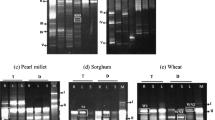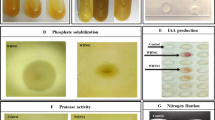Abstract
The modulation in physiological and metabolic attributes associated with colonisation by cyanobacteria in wheat has been little explored. In the present investigation, the performance of six selected cyanobacterial strains was evaluated with wheat (variety HD2687). The fresh weight of plants, measured after 2 weeks, exhibited a 30–60 % increase, while 14–40 % increase in plant dry weight was also recorded, as compared to uninoculated control. The nitrogen-fixing potential (expressed as acetylene-reducing activity or ARA) was 20-fold higher in the treatment involving inoculation of Anabaena laxa RPAN8 as compared to that in the uninoculated control. The inoculation of Calothrix sp. RPC1 brought about a more than 90 % increase in endoglucanase activity and root chlorophyll. Comparison of DNA fingerprints (highly iterated palindrome (HIP)-TG profiles) of wheat roots with those of corresponding pure cultures revealed a high degree of similarity, confirming the colonisation. Significant correlation of plant parameters with nitrogen-fixing potential and growth attributes and fingerprints of cyanobacteria from roots further illustrated the novelty of our results. This represents a first report on understanding hydrolytic enzyme-mediated colonisation of cyanobacteria on roots of wheat plants using plant growth parameters and DNA fingerprints. Such synergistic combinations of cyanobacterium and wheat can lead to savings of nitrogen and increased yields, besides being a prelude to generating nitrogen-independent wheat plants.





Similar content being viewed by others
References
Buchanan M, Burton R, Dhugga K, Rafalski A, Tingey S, Shirley N, Fincher G (2012) Endo-(1,4)-beta-glucanase gene families in the grasses: temporal and spatial Co-transcription of orthologous genes. BMC Plant Biol 12(1):235
Çakmakçi R, Dönmez F, Aydın A, Şahin F (2006) Growth promotion of plants by plant growth-promoting rhizobacteria under greenhouse and two different field soil conditions. Soil Biol Biochem 38:1482–1487
Chaudhary V, Prasanna R, Bhatnagar AK (2012) Modulation of fungicidal potential of Anabaena strains by light and temperature. Folia Microbiol 57:199-208
Cox WJ, Reisenauer HM (1973) Growth and ion uptake by wheat supplied nitrogen as nitrate, or ammonium, or both. Plant Soil 38:363–380
Daizy R, Kohli RK (1991) Fresh matter is not an appropriate relation unit for chlorophyll content: experience from experiments on effect of herbicide and allelopathic substance. Photosynthetica 25:655–657
Dobbelaere S, Vanderleyden J, Okon Y (2003) Plant growth-promoting effects of diazotrophs in the rhizosphere. Crit Rev Plant Sci 22:107–149
Dommergues Y, Balandreau J, Rinaudo G, Weinhard P (1973) Non-symbiotic nitrogen fixation in the rhizospheres of rice, maize and different tropical grasses. Soil Biol Biochem 5:83–89
Felsenstein J (1981) Evolutionary trees from DNA sequences: a maximum likelihood approach. J Mol Evol 17:368–376
Gantar M (2000) Mechanical damage of roots provides enhanced colonization of the wheat endorhizosphere by the dinitrogen-fixing cyanobacterium Nostoc sp. strain 2S9B. Biol Fertil Soils 32:250–255
Gantar M, Elhai J (1999) Colonization of wheat para-nodules by the N2-fixing cyanobacterium Nostoc sp. strain 2S9B. New Phytol 141:373–379
Gantar M, Kerby NW, Rowell P, Obreht Z (1991) Colonization of wheat (Triticum vulgare L.) by N2-fixing cyanobacteria: I. A survey of soil cyanobacterial isolates forming associations with roots. New Phytol 118:477–483
Gantar M, Kerby NW, Rowell P, Obreht Z, Scrimgeour C (1995) Colonization of wheat (Triticum vulgare L.) by N2-fixing cyanobacteria. New Phytol 129:337–343
Gupta V, Prasanna R, Chaudhary V, Nain L (2012) Biochemical, structural and functional characterization of two novel antifungal endoglucanases from Anabaena laxa. Biocatal Agric Biotechnol 1:338–347
Gupta V, Ratha SK, Sood A, Chaudhary V, Prasanna R (2013) New insights into the biodiversity and applications of cyanobacteria (blue-green algae)—prospects and challenges. Algal Res 2:79–97
Hageman RH (1984) Ammonium versus nitrate nutrition of higher plants. In: Nitrogen in crop production. Am Soc Agron, Madison, WI, p. 804
Hiroki M, Shimizu A, Li R, Watanabe M, Watanabe MM (1998) Development of a database system useful for identification of Anabaena spp. (Cyanobacteria). Phycol Res 46:85–93
Hisbergues M, Christiansen G, Rouhiainen L, Sivonen K, Börner T (2003) PCR-based identification of microcystin-producing genotypes of different cyanobacterial genera. Arch Microbiol 180:402–410
Jaiswal P, Prasanna R, Nayak S, Sood A, Suseela MR (2008) Characterization of rhizo-cyanobacteria and their associations with wheat seedlings. Egypt J Biol 10:20–27
Karthikeyan M, Radhika K, Mathiyazhagan S, Bhaskaran R, Samiyappan R, Velazhahan R (2006) Induction of phenolics and defense-related enzymes in coconut (Cocos nucifera L.) roots treated with biocontrol agents. Braz J Plant Physiol 18:367–377
Karthikeyan N, Prasanna R, Lata N, Kaushik BD (2007) Evaluating the potential of plant growth promoting cyanobacteria as inoculants for wheat. Eur J Soil Biol 43:23–30
Karthikeyan N, Prasanna R, Sood A, Jaiswal P, Nayak S, Kaushik BD (2009) Physiological characterization and electron microscopic investigation of cyanobacteria associated with wheat rhizosphere. Folia Microbiol 54:43–51
Kaushik BD (2004) Use of blue green algae and Azolla biofertilizer in rice cultivation and their influence on soil properties. In: Jain PC (ed) Microbiology and Biotechnology for sustainable development. CBS, New Delhi, pp 166–184
Kloepper J, Ryu C-M (2006) Bacterial endophytes as elicitors of induced systemic resistance. In: Schulz BE, Boyle CC, Sieber T (eds) Microbial root endophytes, vol 9. Soil biology. Springer, Berlin, pp 33–52
Knight CD, Adams DG (1996) A method for studying chemotaxis in nitrogen fixing cyanobacterium-plant symbioses. Physiol Mol Plant Pathol 49:73–77
Kovtunovych G, Lar O, Kleiner D, Kozyrovska N (1999) Enhancing the internal plant colonization rate with endophytic nitrogen-fixing bacteria. Biopolimery i Kletka 15(4):300–305
Loon LCV, Bakker PAHM, Pieterse CMJ (1998) Systematic resistance induced by rhizosphere bacteria. Annu Rev Phytopathol 36:453–483
Lucas García JA, Probanza A, Ramos B, Colón Flores JJ, Gutiérrez Mañero FJ (2004) Effects of plant growth promoting rhizobacteria (PGPRs) on the biological nitrogen fixation, nodulation, and growth of Lupinus albus l. cv. Multolupa. Eng Life Sci 4:71–77
Mackinney G (1941) Absorption of light by chlorophyll solutions. J Biol Chem 140(2):315–322
Mäder P, Kaiser F, Adholeya A, Singh R, Uppal HS, Sharma AK, Srivastava R, Sahai V, Aragno M, Wiemken A, Johri BN, Fried PM (2011) Inoculation of root microorganisms for sustainable wheat–rice and wheat–black gram rotations in India. Soil Biol Biochem 43:609–619
Manjunath M, Prasanna R, Nain L, Dureja P, Singh R, Kumar A, Jaggi S, Kaushik BD (2009) Biocontrol potential of cyanobacterial metabolites against damping off disease caused by Pythium aphanidermatum in solanaceous vegetables. Arch Phytopathol Plant Protect 43:666–677
McCowen S, MacArthur L, Gates J (1986) Azolla fern lectins that specifically recognize endosymbiotic cyanobacteria. Curr Microbiol 14:329–333
Nain L, Rana A, Joshi M, Jadhav S, Kumar D, Shivay YS, Paul S, Prasanna R (2010) Evaluation of synergistic effects of bacterial and cyanobacterial strains as biofertilizers for wheat. Plant Soil 331:217–230
Nayak S, Prasanna R, Pabby A, Dominic TK, Singh PK (2004) Effect of urea, blue green algae and Azolla on nitrogen fixation and chlorophyll accumulation in soil under rice. Biol Fertil Soils 40:67–72
Nayak S, Prasanna R, Prasanna BM, Sahoo D (2009) Genotypic and phenotypic diversity of Anabaena isolates from diverse rice agro-ecologies of India. J Basic Microbiol 49:165–177
Obreht Z, Kerby N, Gantar M, Rowell P (1993) Effects of root-associated N2-fixing cyanobacteria on the growth and nitrogen content of wheat (Triticum vulgare L.) seedlings. Biol Fertil Soils 15:68–72
Patil HJ, Srivastava AK, Singh DP, Chaudhari BL, Arora DK (2011) Actinomycetes mediated biochemical responses in tomato (Solanum lycopersicum) enhances bioprotection against Rhizoctonia solani. Crop Prot 30:1269–1273
Piromyou P, Buranabanyat B, Tantasawat P, Tittabutr P, Boonkerd N, Teaumroong N (2011) Effect of plant growth promoting rhizobacteria (PGPR) inoculation on microbial community structure in rhizosphere of forage corn cultivated in Thailand. Eur J Soil Biol 47:44–54
Prasanna R, Lata, Tripathi R, Gupta V, Middha S, Joshi M, Ancha R, Kaushik BD (2008) Evaluation of fungicidal activity of extracellular filtrates of cyanobacteria-possible role of hydrolytic enzymes. J Basic Microbiol 48:186–194
Prasanna R, Jaiswal P, Nayak S, Sood A, Kaushik B (2009) Cyanobacterial diversity in the rhizosphere of rice and its ecological significance. Indian J Microbiol 49:89–97
Prasanna R, Joshi M, Rana A, Shivay Y, Nain L (2012) Influence of co-inoculation of bacteria-cyanobacteria on crop yield and C–N sequestration in soil under rice crop. World J Microbiol Biotechnol 28:1223–1235
Prasanna R, Chaudhary V, Gupta V, Babu S, Kumar A, Singh R, Shivay Y, Nain L (2013a) Cyanobacteria mediated plant growth promotion and bioprotection against Fusarium wilt in tomato. Eur J Plant Pathol 136:337–353
Prasanna R, Sharma E, Sharma P, Kumar A, Kumar R, Gupta V, Pal R, Shivay Y, Nain L (2013b) Soil fertility and establishment potential of inoculated cyanobacteria in rice crop grown under non-flooded conditions. Paddy Water Environ 11:175–183
Prasanna R, Triveni S, Bidyarani N, Babu S, Yadav K, Adak A, Khetarpal S, Pal M, Shivay YS, Saxena AK (2013c) Evaluating the efficacy of cyanobacterial formulations and biofilmed inoculants for leguminous crops. Arch Agron Soil Sci 60:1–18
Rai AN (1990) CRC Handbook of Symbiotic Cyanobacteria. CRC Press Inc., Boca Raton
Rai AN, Soderback E, Bergman B (2000) Cyanobacterial plant symbioses. New Phytol 147:449–481
Rasmussen U, Svenning MM (1998) Fingerprinting of cyanobacteria based on PCR with primers derived from short and long tandemly repeated repetitive sequences. Appl Environ Microbiol 64:265–272
Saitou N, Nei M (1987) The neighbor-joining method: a new method for reconstructing phylogenetic trees. Mol Biol Evol 4:406–425
Singh RK, Chaudhary BD (1979) Biometrical methods in quantitative genetic analysis. Kalyani Publishers, Ludhiana, p 303
Singh D, Prabha R, Yandigeri M, Arora D (2011) Cyanobacteria-mediated phenylpropanoids and phytohormones in rice (Oryza sativa) enhance plant growth and stress tolerance. Anton van Leeuw 100:557–568
Spiller H, Stallings W Jr, Woods T, Gunasekaran M (1993) Requirement for direct association of ammonia-excreting Anabaena variabilis mutant (SA-1) with roots for maximal growth and yield of wheat. Appl Microbiol Biotechnol 40:557–566
Stanier RY, Kunisawa R, Mandel M, Cohen-Bazire G (1971) Purification and properties of unicellular blue-green algae (order Chroococcales). Bacteriol Rev 35:171–205
Tamura K, Dudley J, Nei M, Kumar S (2007) MEGA4: Molecular Evolutionary Genetics Analysis (MEGA) software version 4.0. Mol Biol Evol 24:1596–1599
Thompson JD, Gibson TJ, Higgins DG (2002) Multiple sequence alignment using ClustalW and ClustalX. In: Current protocols in bioinformatics. John Wiley Sons, Inc.
Venkataraman GS (1972) Algal biofertilizer and rice cultivation. Today and Tomorrow Publications, New Delhi
Venkataraman GS, Neelakantan S (1967) Effect of cellular constituents of nitrogen fixing blue green alga Cylindrospermum on root growth of rice plants. J Gen Appl Microbiol 13:53–62
Weisburg WG, Barns SM, Pelletier DA, Lane DJ (1991) 16S ribosomal DNA amplification for phylogenetic study. J Bacteriol 173:697–703
Weissman GS (1951) Nitrogen metabolism of wheat seedlings as influenced by the ammonium: nitrare ratio and the hydrogen ion concentration. Am J Bot 38:162–174
Acknowledgments
This study was supported partially by the funds from the Application of Microorganisms in Agricultural and Allied Sectors (AMAAS) Network Project on Microorganisms (Themes: Microbial Genomics; Nutrient Management) granted by Indian Council of Agricultural Research (ICAR), New Delhi. The authors are also grateful to the National Phytotron Facility and Division of Microbiology, IARI, New Delhi, for providing the necessary facilities for undertaking this study. The authors state that they have no conflicts of interest.
Author information
Authors and Affiliations
Corresponding author
Electronic supplementary material
Below is the link to the electronic supplementary material.
Supplementary Table 1
(DOC 37 kb)
Supplementary Table 2
(DOC 53 kb)
Supplementary Table 3
(DOC 58 kb)
Rights and permissions
About this article
Cite this article
Babu, S., Prasanna, R., Bidyarani, N. et al. Analysing the colonisation of inoculated cyanobacteria in wheat plants using biochemical and molecular tools. J Appl Phycol 27, 327–338 (2015). https://doi.org/10.1007/s10811-014-0322-6
Received:
Revised:
Accepted:
Published:
Issue Date:
DOI: https://doi.org/10.1007/s10811-014-0322-6




